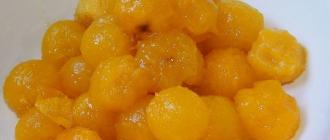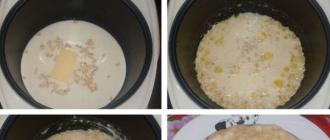Hake is the most healthy, tasty and convenient representative of cod species. Its meat contains a lot of vital vitamins, minerals, proteins and fats. You could create an entire cookbook based on it, and the hake bones seem to be just looking for a reason to jump out of the fillet as quickly as possible. Fantastic? That's another thing. Let's get to know him better...
Brief information
Hake belongs to the Merluzov family, lives in the salty waters of the oceans, and is caught in shallow waters. The length of the hake can reach up to one and a half meters, but much more often it is only 30-40 centimeters.
Hake is very attractive from a culinary point of view because it has very few bones, which are also very easy to remove. In addition to this, hake meat is considered low-fat and can be used as a dietary component in the human diet.
When fresh, the carcasses of this fish do not retain their smell and taste well, so they are quickly frozen. Moreover, both whole carcasses and fillets prepared for consumption.
Useful properties of hake
Hake meat is filled to the brim with useful substances, which include such important minerals as calcium, phosphorus, iron, zinc, iodine; vitamins PP, B, A, E and C, as well as easily digestible proteins.
Despite the fact that hake is considered a lean fish, it contains quite a lot of useful omega-3 acid. This is especially true for caviar. Therefore, if you have hints of diabetes, cardiovascular disease or hypertension, try very hard to buy hake along with caviar.
By the way, researchers have noticed that hake caviar also has a very beneficial effect on the central nervous system, thyroid gland and even the human reproductive system.
In addition to the listed advantages, lovers of this fish meat get rid of toxins and free radicals with each new serving, and also maintain the desired blood sugar level.
Contraindications
It is important that the hake is frozen only once and stored according to technology. Otherwise, after defrosting, it will turn from an ice block into structureless, tasteless nonsense, suitable only for “feeding” the trash can.
This means that you need to learn to distinguish freshly frozen fish from flaccid, tasteless fish.
The main criterion for the quality of hake is the ratio of the size and weight of the carcass. A good fish should be moderately heavy.
If hake looks like it weighs no more than 200 grams, but the scale shows 400, then know that the manufacturer did his best and sincerely “saturated” his product with water. Consequently, you will overpay twice for the goods, and you will receive not fish, but a bunch of fibers torn by ice.
At the same time, there should still be a thin layer of ice glaze on the fish, otherwise during storage it will dry out and lose its taste and smell.
Although hake is considered an extremely healthy and tasty fish, we are lucky that we rarely (or even never!) see it with its head. Many of us ask the question: “Why is hake sold without a head?”
What do we know about hake? This is a fairly valuable commercial fish, which is very popular in Western Europe, especially in Spain and Portugal. Many of us know hake under another name, namely hake. Hake meat is so valuable that in some cases it is even used in dietary nutrition. It is recommended to use it for the normal balance of iodine in the body and as a source of valuable Omega-3 fatty acid.
But what scared users so much about hake that at one point all the news feeds simply exploded with the phrase: “That’s why they sell hake without a head!”? In fact, the hake is a predatory fish and this feature is reflected in the structure of its body and especially its head. This feature is well known to fishermen and those who process this fish. Look:
As a rule, carcasses or fillets are sold in stores and markets.

Make no mistake, this won’t last long: the overall impression will change as soon as the fish opens its mouth

Photo: Roger Casas-Alatriste https://www.flickr.com/photos/casasroger/26428344030/ (https://creativecommons.org/licenses/by-nd/2.0/)

The fish department will never be the same again...

Photo: https://pxhere.com/da/photo/1041015 CC0 Public Domain

Photo: NOAA Photo Library https://www.flickr.com/photos/noaaphotolib/5187498791/ (https://creativecommons.org/licenses/by/2.0/)

Photo: Procsilas Moscas https://www.flickr.com/photos/procsilas/3335124268/ (https://creativecommons.org/licenses/by/2.0/)
We told you that hake is a predatory fish. But this is actually not a bad thing, because largely due to her lifestyle, she is so rich in nutrients.
Now I understand why hake is sold without a head!
Main photo: Joe https://www.flickr.com/photos/ /4867479690/ (https://creativecommons.org/licenses/by/2.0/)
makamuki0-1102736 CC0 Creative Commons
Post navigation
You might also be interested

Demi Rose shared her mood and photos from quarantine

A selection of little-known TV series that are worth watching

Milan: After people disappeared from the streets, city parks were overrun by wild rabbits

If yes, then you most likely already know the information from our article, but it is likely that you will discover something new for yourself.
Be that as it may, almost every one of us loves fish and seafood. If, for example, you don’t like pickled herring or baked mackerel, then you probably won’t refuse fillet salmon or sturgeon.
Who among us doesn’t love sandwiches with delicate butter and delicious, so-called red fish? And even more so, lovely ladies love sushi, an important ingredient of which, in addition to rice, is salmon fillet.

Today we want to shed light on a question that has long tormented hundreds and thousands of people. Why everyone's favorite hake sell without a head?

First, let's figure out who hake is and why we love the meat of this fish so much. Hake is a sea fish from the order cod. It is recognized as the most delicious and healthy fish among cod.

Adults reach a length 50–70 centimeters and weight 2.5–3 kilograms. The body of the fish is flat and elongated. The meat is lean, tender and easily separates from most of the bones.

Hake is a predatory fish. In the first years of life it feeds temisto, Kalyanus And shrimp. Upon reaching sexual maturity, it begins to hunt herring, mackerel and squid.

The most successful representatives of cod live up to 10–12 years. Most are caught in fishermen's nets, and then sent to the shelves, where we buy them.

And they sell them without heads because they don’t want to traumatize your delicate child’s psyche. Just look at this evil face of a killer who, without remorse, guts poor mackerel, squid and other small things. Pregnant women and children, please scroll through the photos of these bandits as you continue reading.


Gotcha? It's a joke! In fact, the hake is decapitated so that the meat can be stored longer. As you know, the fish rots from the head, so you have to cut it off and give it to the cat Vaska to be torn to pieces.

In addition we want to give you a couple of tips that should guide you when purchasing this fish. You need to carefully inspect the hake to make sure that the carcass has not been re-frozen.
Usually, after freezing, the fish is covered with a thin layer of ice to prevent it from drying out during storage. Some unscrupulous sellers freeze fish so much that layer of ice exceeds the weight of the carcass itself. It turns out that the buyer pays for the water. In addition, with such freezing, the taste is lost.

You should also give up fish, which too light. This is a sure sign that it has been frozen for a long time and has already dried out.

If the shape of a fish unnatural, broken, then most likely it was frozen several times. Immediately throw this crap away and run to another store.

We won’t tell you about how to prepare hake. Each housewife has her own favorite recipes and secret ingredients that make fish dishes unique.

I hope that the deadly jaws of the hake did not frighten you too much and did not discourage you from buying the meat of this fish. Whatever one may say, hake is a predator that ends up on the table of the main link in the food chain of our planet - man.
Share with us your recipes for preparing this fish and tell us if its ominous face scared you?
Under the USSR, hake appeared more often than other fish on the menu of catering establishments when a “fish day” was announced. Only blue whiting could compete with it. Hake was cheap, readily available, and considered by some to be an unworthy fish that could only be served by cheap eateries. Today, in times of food abundance, people have come to appreciate hake. Even Europe considers the fish the best among 31 varieties of cod.
What hake fish looks like: photo and description
Also known as hake. This is a predatory fish, the population of which is impressive, although experts believe that it has declined due to active fishing. The size of an adult hake (hake) from 30 cm is 1.5 m.
Belongs to the monotypic genus, family - hake, which includes 16 species. The hake spends most of its time at depth, rising higher when hunting.

Appearance: slender body, large head, 1/3-1/4 of body length. It has an elongated compressed snout 1.3-3.2 times the diameter of the eye, with a wide rounded tip. The eyes are large, located on the sides of the head. Between them there is a vast interorbital space, it is slightly elevated, 1.0-2.4 eye diameters wide. The mouth is narrow. The lower jaw is longer than the upper, there is no mustache on the chin. The jaws are equipped with vomer teeth. The first ray of the dorsal fin is long and flexible, and the pelvic fin contains 7-9 rays. The hake differs from other representatives of the hake family in its caudal fin - it is located separately from the anal or dorsal. Also, it has a second dorsal and anal fin of almost the same height.
The body color is silver with a steel back. The sides are lighter and the belly is silvery. There are black varieties. The iris of the eye is golden and the pupil is black.
Habitat
All varieties of hake are actively used in cooking. They are caught using special bottom trawls. Hake is sold fresh and frozen; a separate part of the catch is used to make fishmeal.
Where is it found?
| Kind of me rluzy | Terrain |
| Silver | North America, in the territory from the Strait of Belle Isle further to the outskirts of the Bahamas. Fish are found at depths ranging from 50-900 m. Most fish are found in the southern side of Newfoundland, also in South Carolina. |
| Pacific | Northeast side of the Pacific Ocean, sometimes found in the southeast side of the Bering Sea. Capture is carried out annually. |
| Argentine | Near the Atlantic coast of the outskirts of South America, also off the coast of Southern Brazil, further to the edge of the Falkland Islands. Argentina and Uruguay catch it more than other countries. |
| Chilean | Pacific coasts off Peru, Chile. |
| New Zealand | Commonly found off the coast of the outskirts of New Zealand, including around Patagonia. Serves as an object of constant fishing. |
| Cape | The coast of Angola to the territory of South Africa. |
Hake loves bottom areas; its body can withstand great pressure. Therefore, the fish calmly descends to a kilometer depth. They are caught from there by deep trawls. Fish move in schools that rise higher during the hunting season.
Hake is also found in Russia, only in artificially populated reservoirs.
Hake fish: benefits and harm
Most often, hake is found frozen on store shelves. This is how fish is transported from its catch sites, preserving maximum of its beneficial properties.
What macro and microelements does hake contain:
| M metals | Vitamins |
| phosphorus; zinc; iodine; potassium; magnesium; iron; fluorine; calcium; sodium; sulfur; chlorine; manganese; copper; nickel; cobalt. | B1, B2; B6; B9; AT 12; PP; Omega-3. Other unsaturated natural fatty acids. |
With such an impressive range of beneficial substances, fish can be used as a natural medicine against certain diseases. For example:
- Diseases of the endocrine system - seafood is always rich in iodine, but the thyroid gland lacks it.
- Nerve disorders - it is known that destroyed nerve cells will not recover. Regular consumption of fish has a beneficial effect on the central nervous system.
- Diabetes – patients with this diagnosis must follow a special diet, monitor their sugar levels and regularly take a number of medications. Hake makes excellent dietary dishes; in addition, it is healthy and caviar can lower dangerous sugar levels.
In addition to its positive qualities, fish has contraindications:
- Allergies – Most seafood can cause severe reactions. Heck too. Therefore, before use, you should check for individual intolerance.
- Constipation – fillet contains enough iron, and its binding effect is contraindicated in case of constipation.
- Increased acidity in the body. People suffering from this disease should not eat hake.
You shouldn’t give hake to kids either, although it’s easy to remove the bones from the meat. There is a risk that the child will choke.
Is hake a sea fish or a river fish?
Belongs to marine fish and the large cod family. In Europe, she has long been recognized as the best representative of her family. Therefore, hake is actively caught and sold everywhere.

Previously, in Russia, hake was considered a cheap and low-quality product. He reminded people of times of shortage, when only hake was on the counter among fish products. Now people's opinions have changed.
Hake fish: calories
Saturated acids – 0.6, carbohydrates – 0.
Due to its low calorie content, hake is easy to prepare dietary dishes.
How much does hake fish cost?
Under the USSR, it was pleasing at an affordable price, so people often bought it for holidays or ordinary days.

Hake fish price per 1 kg in various establishments
| Product, shop | Price | Quantity |
| Headless carcass (“Metro online store” from Moscow) | 229 rubles | 1 kg |
| Carcass (“Verny”, Kaluga) | 299.9 rubles | 1 kg |
| Carcass (“Faithful” from the Leningrad region) | 299.9 rubles | 1 kg |
| Carcass (“Faithful”, Vladimir) | 299.9 rubles | 1 kg |
| Frozen carcass (“Platypus online store”, Moscow) | 289 rubles | 1 kg |
The cost of a kilogram of hake ranges from 230-300 rubles.
Hake fish: how to cook deliciously in the oven
Among the known options for preparing fish, the best way is to bake it. This way the dish will be less caloric, and in addition, a novice housewife can cope with this task. Baking is better than traditional frying because... the kitchen remains clean after culinary experiments and there is no fishy smell. Foil helps. It can withstand high temperatures perfectly, while at the same time preserving the quality of the prepared product.
The recipe is simple and requires a minimum of ingredients. You can supplement it with potatoes by cutting them into medium slices. Then the question of a side dish will automatically disappear. Or add canned beans. Simple, tasty, healthy and satisfying!
Ingredients:
- hake fish – 2 pcs.;
- lemon;
- bay leaf – 1 pc.;
- black pepper;
- salt;
- dry garlic - a pinch;
- olive oil – 1-2 tbsp;
- leek/regular onion.
Preparation:

- Preparation of carcasses. It is necessary to clean the fish, cut off the fins and rinse it thoroughly. Culinary scissors will help here. It is better to remove entrails from a frozen carcass. This makes the procedure easier.
- Place a sheet of foil on the bottom of the baking dish. On top are both carcasses of peeled hake. Salt them on all (top, bottom, inside) sides. The bay leaf can be placed inside or left nearby. Arrange the lemon slices in a random manner instead of with the onion slices. Add a couple of pinches of pepper.
- Lastly add a little oil. You can pour water instead or do without it. After finishing cooking, cover the top of the fish with foil and bake in the oven, setting it to 120 degrees. The hake is baked for 30 minutes. It is better to wrap the foil loosely, leaving a little space.
For garnish you can use mashed potatoes, buckwheat or rice. The result is a soft, juicy and tasty dish. Instead of a side dish, if you don’t have time (laziness), you should cut a simple salad using fresh vegetables (cabbage, tomatoes, cucumbers) or open a jar of pickles.
How long to cook hake fish for soup - 30 minutes is enough if the water has already boiled. You need to set the heat to low and cover the pan while cooking.
An ordinary post on the entertainment portal Pikabu has become a source of controversy on the Internet. The whole country is currently trying to find photographs of hake fish. The channel website shows what hake looks like in its natural habitat, for sale and on the table.
Hake is an inconspicuous fish from the hake family, which can easily be bought at any market in Russia. However, these days, social media is alive with conversations and memes about hake. The reason for this was a funny post on the Pikabu portal. On it, a user under the nickname VARCHUN13 published a photo of a fish with the face of a monster. According to him, this is what hake looks like in its natural habitat. The post received tens of thousands of views and several thousand likes, and was soon honestly stolen by popular communities on VKontakte and Odnoklassniki. This is what the original post looked like.
Users joked a lot about the appearance of the strange creature. Of course, there were those who doubted the veracity of the recording. Users posted other photos of hake in the comments, where they looked more attractive. However, these pictures did not dissuade the majority of commentators - they only remembered that even girls on Instagram and in real life look very different.
Jokes aside, by the morning of November 14, the meme entered the top search queries on Google and Yandex. People are looking for photos of hake and trying to determine whether ordinary hake look so monstrous “in real life”? We offer a selection of photos of hake from a variety of angles and situations.
What does hake look like - photo of hake
Let's start with the "hake portraits". It turns out that 11 species of fish are classified as hake. They all differ slightly from each other in exterior, that is, in appearance. This means that hake are different - there are both “beautiful” and “ugly” among them.
All hake are distinguished by thin, sharp teeth that look truly scary. They also have an unpleasant scale color - light gray with a mucus effect. Let's be honest - we never found a photo of hake that looked the same as in the Pikabu picture. But let's not call it fake. Among hake there are subspecies that live at a depth of 1000 meters. And deep-sea fish are known for their deformities. In the end, there, in the darkness of the sea, there is simply no one to look at them. As for our searches, the most terrible of the hake found with biological proofs is this one:
By the way, the largest hake reach sizes of 1.5-2 meters. Imagining a monster from a photograph in such dimensions is very scary.
But sometimes hake looks very nice. When? Then when it ends up on our plates and in our pans. Hake meat is tender and juicy and goes well with mashed potatoes, grilled vegetables and other natural side dishes. Hake can be very simply prepared in a slow cooker by frying it with onions and carrots. In Russia, hake is also often baked with vegetables in the oven - this dish goes perfectly with white wine.
How to cook hake? Hake recipes
Here is a small selection of photos of hake from gastronomic Instagrams:
Study recipes. True, in the coming days you will see hake in a different form - in the form of memes. Alas, they will not always be witty. Hang in there, friends! We are waiting for an invasion of funny and at the same time scary surfing the Internet.
Video: cutting hake, Andrej Pristaj





